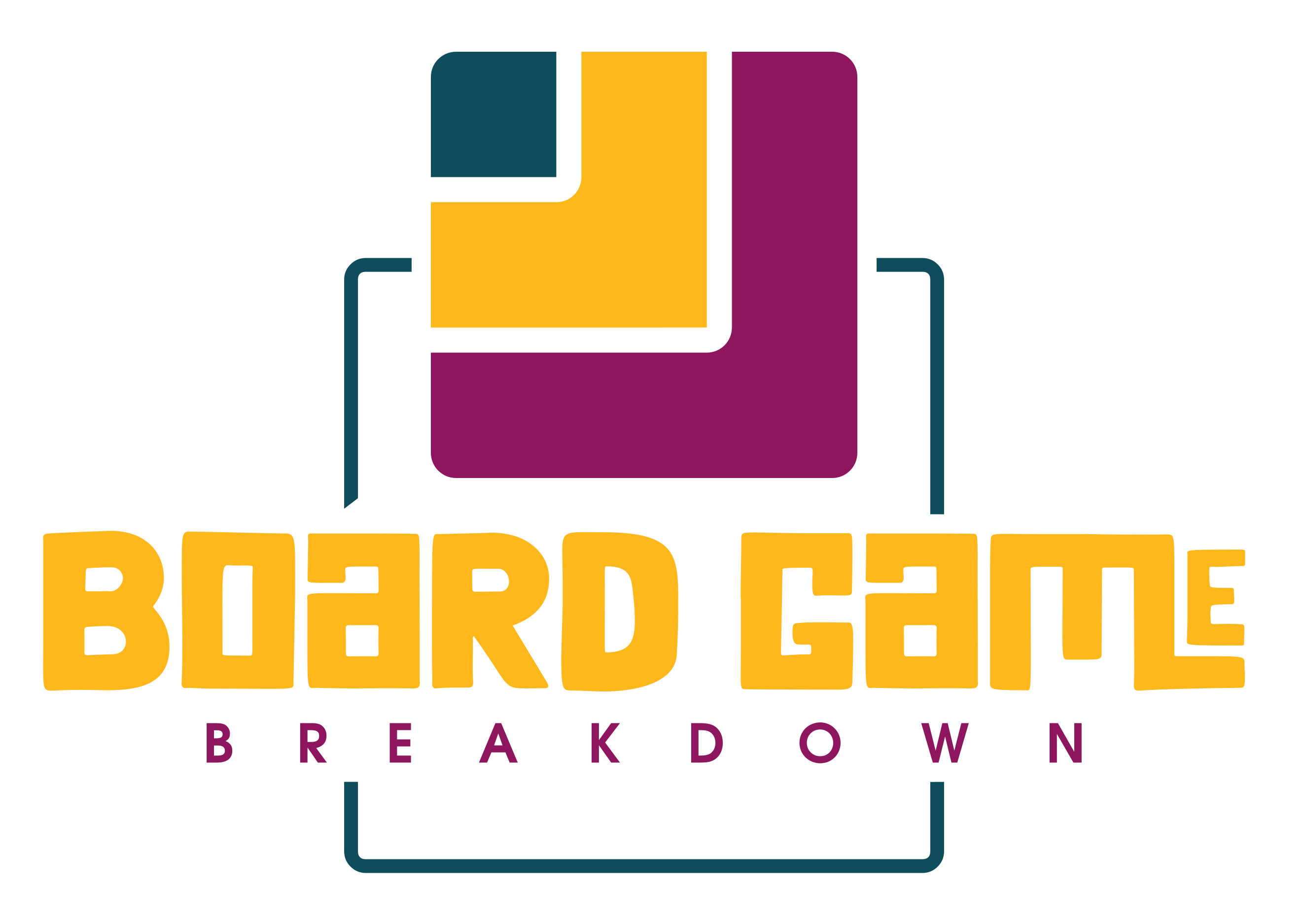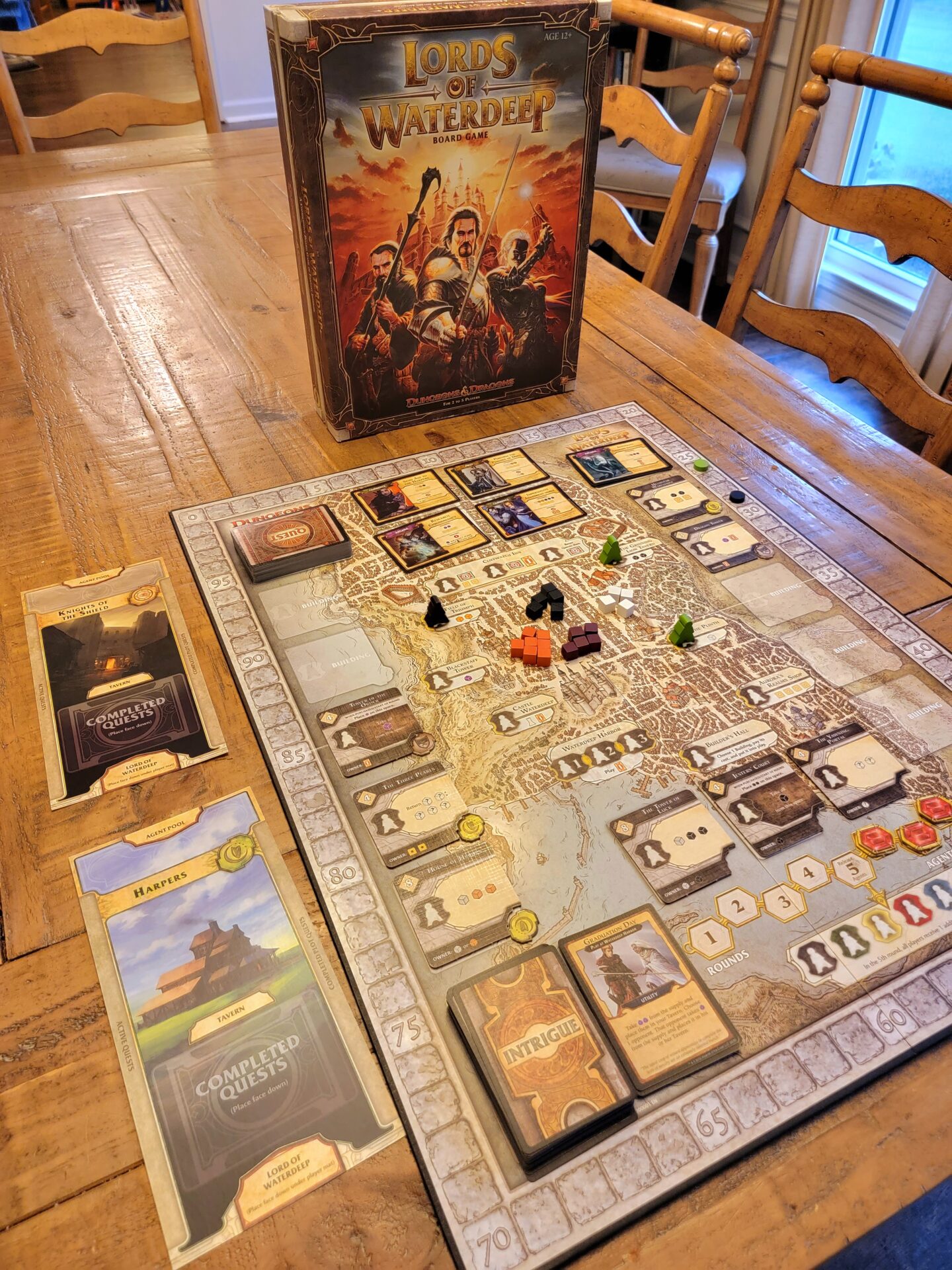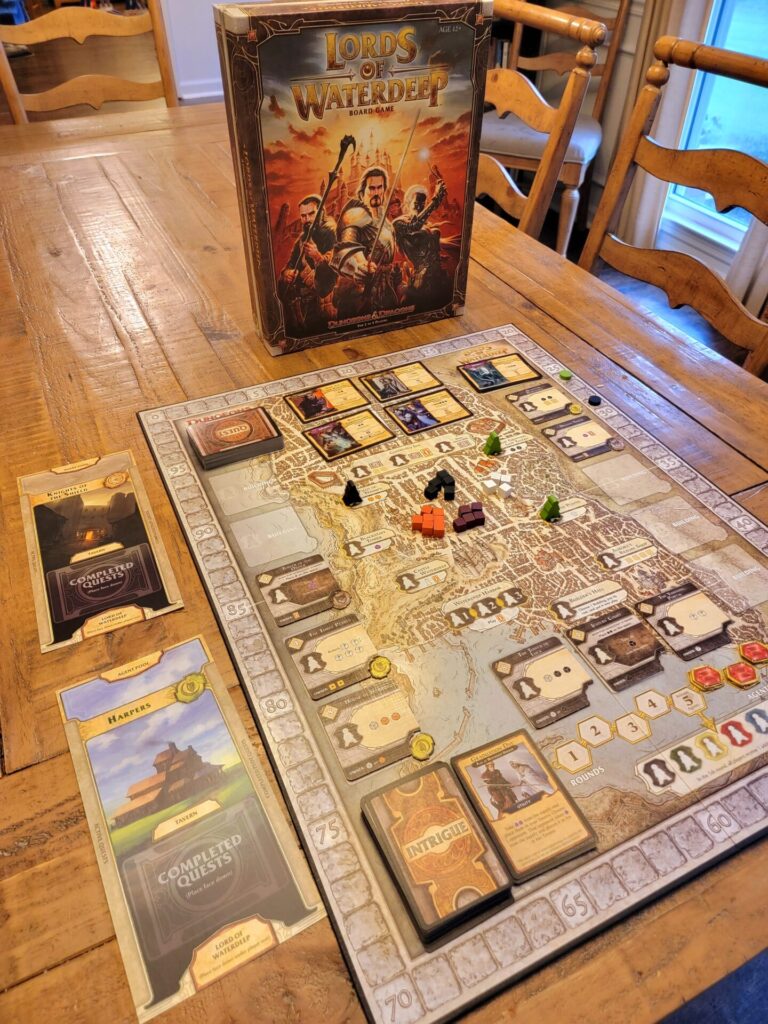
Name: Lords of Waterdeep
Year of Release: 2012
Player Count: 2 – 5 Players
Playing Time: 60 – 120 minutes
Designer: Lee & Rodney Thompson
Publisher: Wizards of the Coast
Primary Mechanisms: Worker Placement, Set Collection, Ownership
Weight (According to boardgamegeek.com): 2.46
This review is a part of the Retrospective Review series where Board Game Breakdown takes a look back at games that were released at least 10 years ago. We will highlight aspects of the game that still work for us after all this time and then the aspects that haven’t lived up to the feelings we had originally. This will all culminate in our normal rating structure at the end of the review.
Introduction
I remember exactly where I happened upon Lords of Waterdeep for the first time in the wild. I was strolling through a Books-A-Million and the enormous box caught my eye. I had a fleeting memory of seeing the cover art somewhere on the internet or maybe reading a review, but I didn’t know much about the game. I faintly remembered it as being mentioned as one of the great “starter” worker placement games but in all honesty, the Dungeons and Dragons setting intimidated me. I had never played D&D and it seemed to be on a completely different level than the modern board games I was coming to love. But standing there in the aisle of that BAM, I was intrigued enough by the artwork and prospect of this giant box in my hands that I quickly took it to the counter before I could change my mind.
So how does Lords of Waterdeep stack up 10 years after its initial release? Read on to see what works and what doesn’t in this city filled with scoundrels and adventurers for hire!
Game Overview
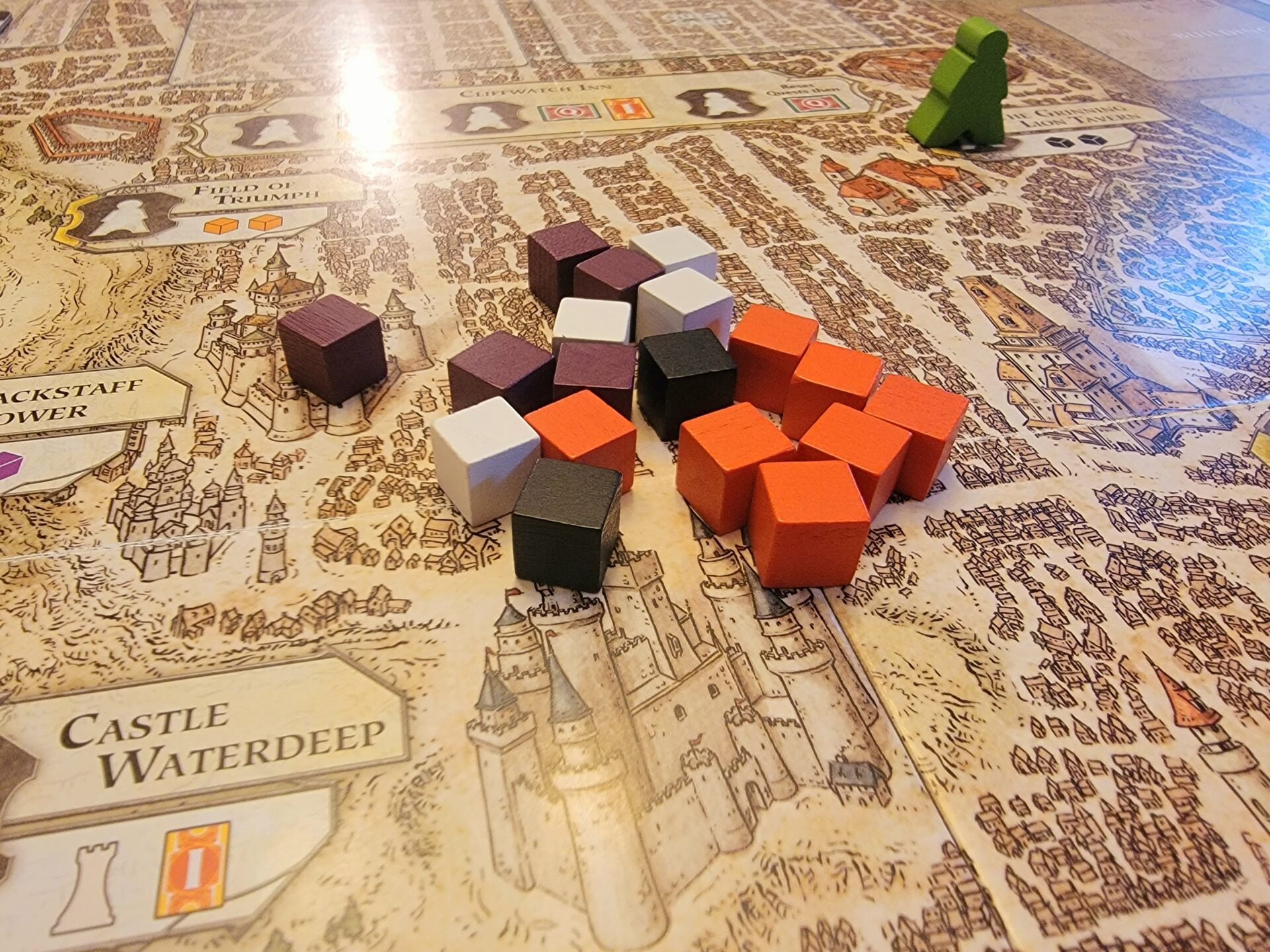
Lords of Waterdeep is a worker placement game where players are vying to recruit adventurers (disguised as colored cubes) to fulfill quests that they have collected. Players essentially take turns deploying workers off to different buildings in order to trigger actions which typically reward the player with either gold or cubes. After a worker is placed, the player has a chance to then turn in the necessary cubes to complete a quest card. This quest card can then be put into the stack of completed quest cards and all rewards on the card are given out.
There are a few spaces that allow for some different actions such as buying new buildings to put on the board, playing cards against your opponent, or drawing new quest cards. The game takes place over eight rounds with players tracking their Victory Points around the edge of the board. At the end, there are some bonus points awarded if the players have met the quest requirements on their individual Lord card given out at the onset of the game. The player with the most Victory Points wins.
What Works – Controlling Buildings
As with many other worker placement games, Lords of Waterdeep features pre-printed action spaces (nine in fact) on the game board. In addition to these spaces, players can buy building tiles to place into one of the ten open building slots around the edge of the city. These building tiles increase the action spaces that players have available to them as the game progresses. When a building tile is placed on the board, the player who bought the building takes one of their control markers and fits it into the corner of the building tile to show that they own the building.

All players are allowed to use any of the open building tiles, but as the owner, that player is given an incentive each time an opponent visits that building. Sometimes this incentive is more gold coins or sometimes it can be additional cubes, I mean, *ahem*… adventurers. I like this wrinkle the game throws in as players need to weigh taking the action and giving their opponent a reward against just trying to reach their goal using another action space. None of the incentives are too overpowering where if your opponent is awarded it, you feel like you’ve made an enormous mistake but they reward enough where players have to at least keep it in mind.
What Works – Intrigue Cards

Personally, I don’t like “gotcha” mechanics in games. A game like Munchkin that solely revolves around this type of mechanic is an absolute travesty in my opinion. With this stance in mind, it surprises me that I like the Intrigue cards in Lords of Waterdeep so much. One reason I like them is none of them will totally wreck you when your opponent plays them against you. Much like the owner benefit on the building tiles, the Intrigue cards cause enough of a pain where you can’t totally ignore them, but you also will probably never throw up your hands or flip the board off the table in a fit of rage when one is played against you.
The second reason I enjoy this piece is the mechanic the game uses to employ the cards. A player must take a worker and place them at the Waterdeep Harbor action space. At this point, the player is allowed to play one Intrigue card against an opponent. Up to three workers can be placed at the harbor throughout the round. After all players have put out all of their workers and all actions have been resolved, the workers at Waterdeep Harbor are given a chance to be redeployed to any spaces that are still unoccupied. I don’t think the Intrigue cards would be as intriguing if you had to waste a worker to play one and that was it but knowing you’ll get to redeploy that worker, even if spaces will probably be fairly limited by then, make it a lot more worthwhile to visit the harbor.
What Works – Quest Card Flavor Text/Quest Card Types/Quest Card Art

Technically, I guess this is three things in their own right but I’m combining them as one point. I didn’t want to simply say that the Quest Card themselves fully work because there are definitely parts that I don’t like about the Quest system, but I do enjoy the “thematic” portions of the Quest Cards. There are five types of quests: Arcana, Skullduggery, Piety, Warfare, and Commerce. All of the flavor text and artwork on the cards matches with the quest type beautifully. You’ll find plenty of pictures and quotes of brave warriors and knights holding huge swords or battle axes on the Warfare cards. Conversely, the Piety cards bring about a feeling of mysticism and spirituality with artwork centered around large temples or sullen looking friars. Sure, the theme is pasted on but it’s still fun to think about your particular Lord focusing on only Arcana and Skullduggery quests because he or she is a backstabbing, two-faced mage with a grudge to settle.
What Doesn’t Work – Quests’ Required Resources
As much as I like the aesthetic functions of the Quest cards, the implementation of the quest system just isn’t all that much fun. Each of the types usually require a majority of a certain colored cube in order to complete the quest. Skullduggery quests usually need a lot of black (Rogue) cubes whereas the Warfare quests usually require a handful of orange (Fighter) cubes. The one difference here is the Commerce types that don’t focus on a particular adventurer but typically require just a few cubes and then a sum of gold coins to complete it.
If you are focusing on a certain one or two types of quests (for the bonus points given by your particular Lord card at the end of the game) this system requires you to mostly collect the same-colored cubes over and over. The effect of this is that you’ll probably be taking a lot of the same action spaces from turn to turn which takes some of the fun out of it.
What Doesn’t Work – Single Worker Placement at Builder’s Hall
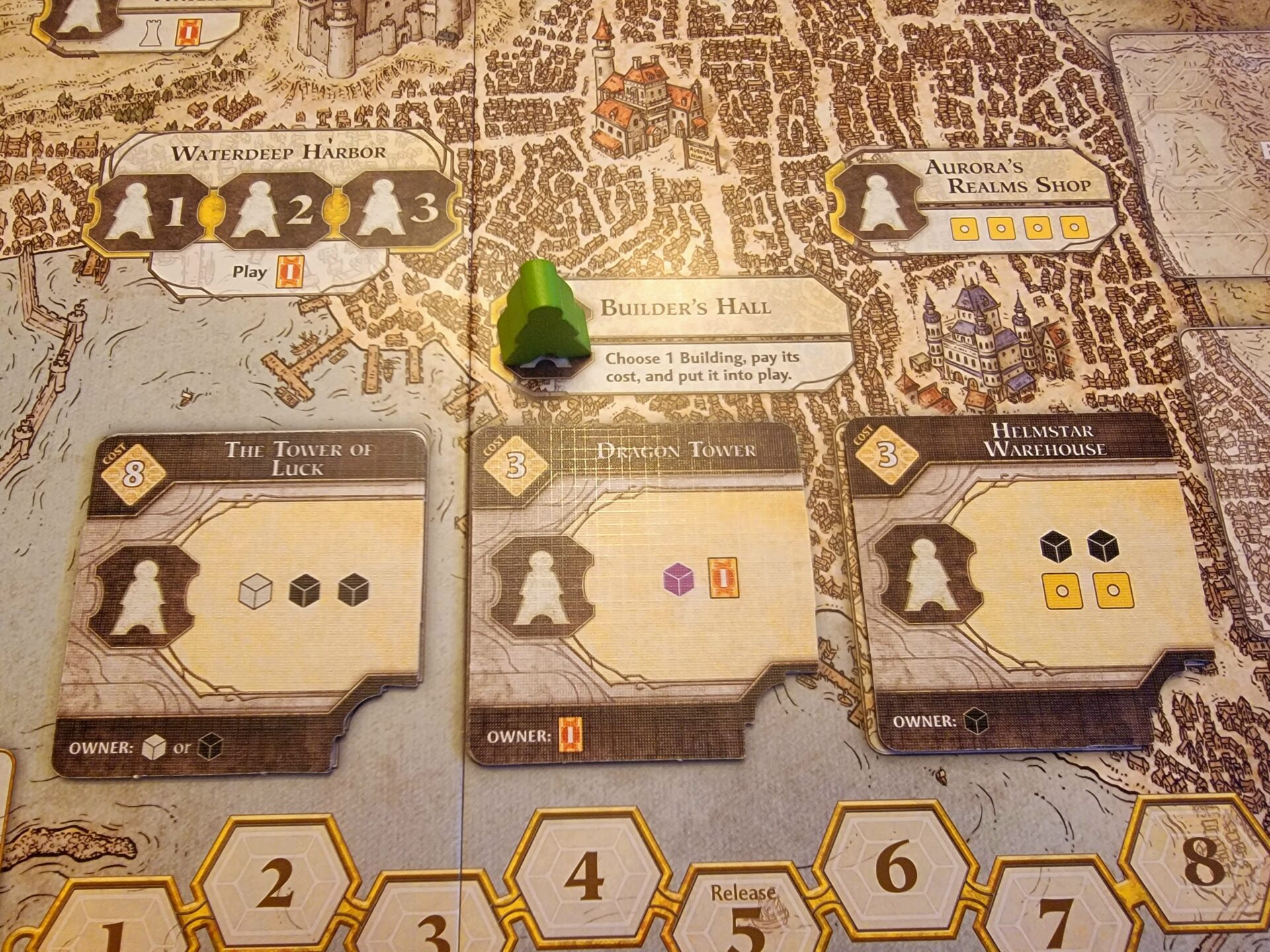
Earlier, I discussed how players can purchase new building tiles to expand the action space options on the board. In order to do this, a worker has to be placed at Builder’s Hall. Only one worker can be placed here each round which substantially decreases the amount of new buildings that are going to make it out to the board. In most games, I only see four or five tiles actually get bought. Depending on the mix of these tiles, it can become tricky to satisfy the requirements for your quests and almost feel fruitless. In a recent game, both my wife and I were shooting for Warfare quests because both our Lords had bonus points associated with those quests. It also didn’t help that the majority of the quests showing up in Cliffwatch Inn early in the game were all Warfare types. This means that the orange cubes were highly sought after but there is only one space on the board which gives you two orange cubes. Throughout the game, we only bought five tiles and none of these rewarded orange cubes in any way, shape, or form, causing the completion of Warfare quests to be quite the slog.
An easy answer seems to be that each player could be limited to one worker at Builder’s Hall per round and that might get more tiles to the table. This reminds me of how Everdell: Bellfaire handles the market space where each player can utilize the market only once per round but allowing each player to use it during a round, they give us more opportunity to use this action.
What Doesn’t Work – Overall Trajectory of the Game
This point just came to me after playing my most recent game of Lords of Waterdeep. I realized that besides round five when you are rewarded an additional worker, there is no real upward trajectory from the beginning of the game to the end. In that last play, I was able to complete one of the quests that rewards you 25 points but that was back in round three or something. Then the rest of the game, I was just piddling around with the normal quests and there just wasn’t any sort of payoff at game end. It felt like I was accomplishing the same things in round eight that I was accomplishing back in round two. This might have more to do with my gaming tastes changing, or maybe it’s just the natural feeling after playing a game for 10 years, but the journey of playing just isn’t as exciting as others in my library.
Conclusion
Lords of Waterdeep is a wonderful “gateway” game, especially those that might be new to the worker placement mechanic. While I have had many fun plays of the game and still like a lot of it, most of the game now falls firmly in the “take it or leave it” category. If a friend wanted to play it, I wouldn’t turn it down, but I don’t think I’ll be clamoring for it again anytime soon.
Rating
Ratings are based on 5 main criteria: rulebook, setup, components, art & graphic design, and gameplay. The first 4 criteria are rated 1 to 5 and the gameplay is rated 1 to 10. These scores culminate in an “overall satisfaction” score that is rated from 1 to 10. If the reviewed game has both a solo and multiplayer mode, I have assigned scores separately to give context to which mode we enjoy more.
Links
As an Amazon Associate I earn from qualifying purchases.
Amazon: Lords of Waterdeep Board Game
